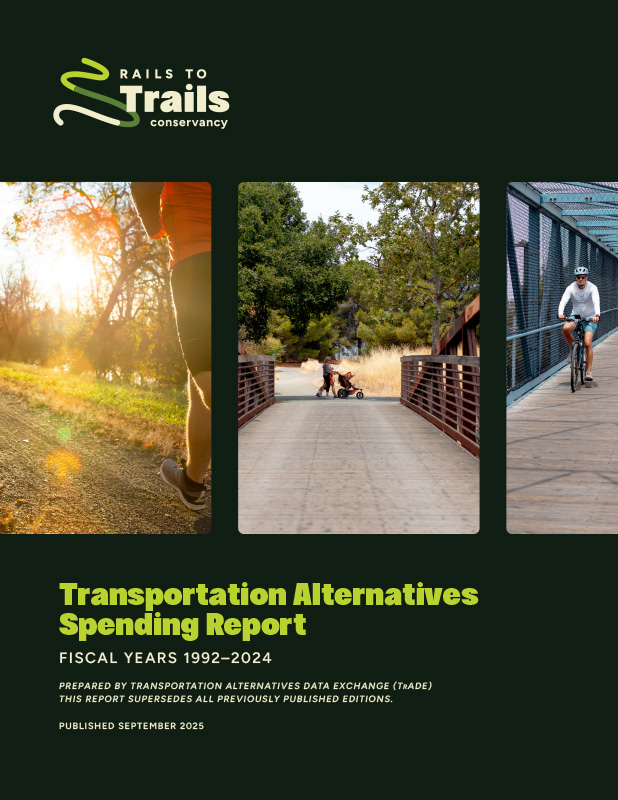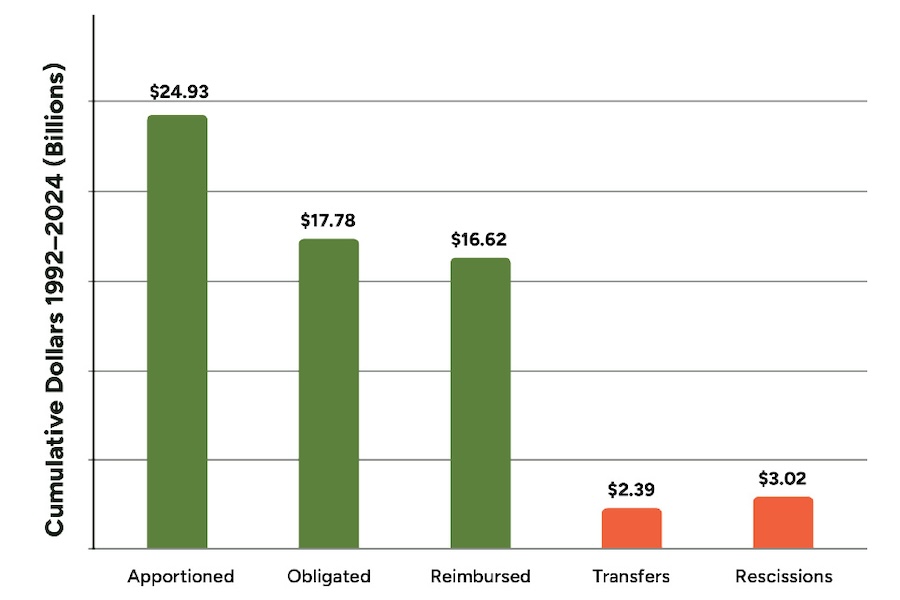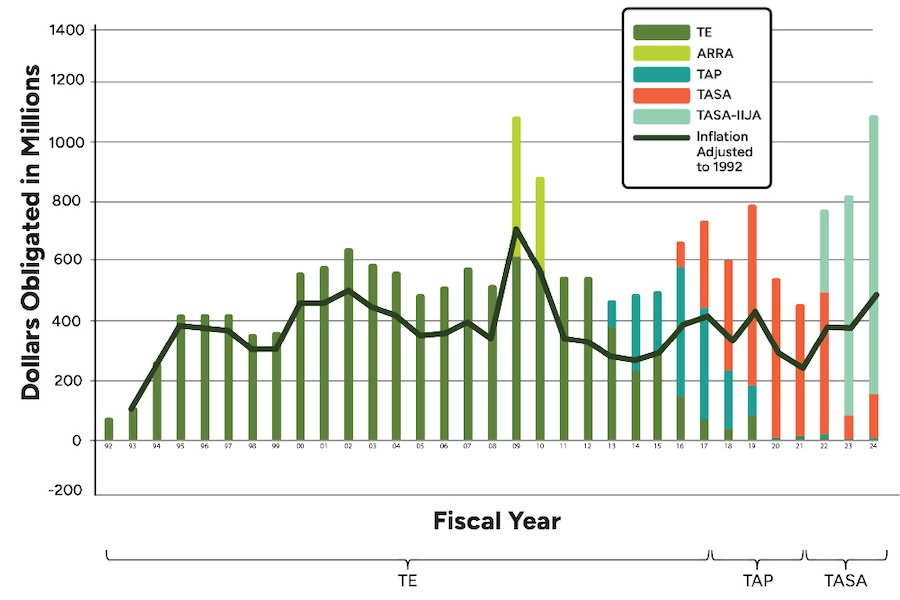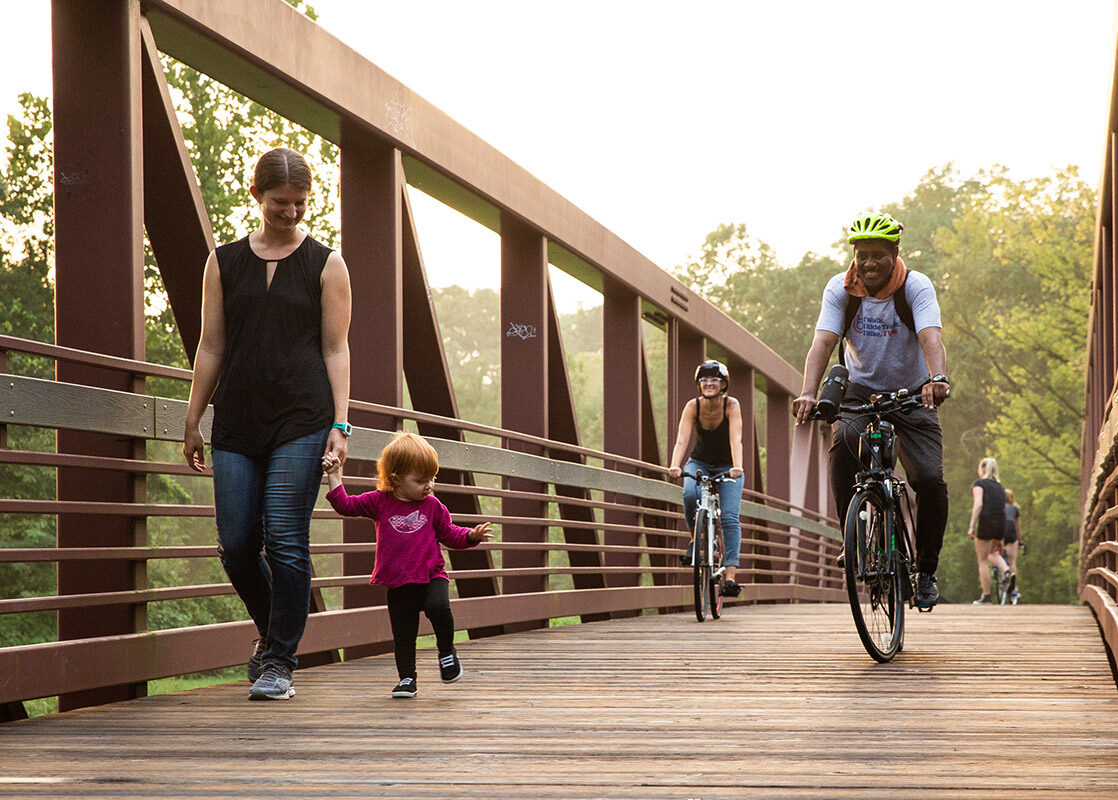Transportation Alternatives Spend Report FY 2024 At A Glance
TrADE Spending Report FY 2024 At A Glance
Description Text Here…
TrADE > FY 2024 At A Glance

View full Transportation Alternatives Spend Report FY 2024
The Transportation Alternatives Set-Aside (TASA) is the largest dedicated source of funding for trails, walking and bicycling in the United States, focused on improving conditions for walking and bicycling. Since 1991, this program, formerly known as Transportation Enhancements (TE) and Transportation Alternatives Program (TAP), has transformed the landscape of the country. This investment has established a foundation for the nation’s active transportation system with 42,000+ miles of multiuse trails and hundreds of developing trail and active transportation networks reaching every single state, alongside thousands of improved street facility projects that support biking and walking. From fiscal year (FY) 1992 through FY 24, Congress apportioned $24.93 billion to the states for TE, TAP and TASA projects. During that time, approximately $2.39 billion was lost to transfers and another $3.02 billion was lost to rescissions. Figure 1 demonstrates the cumulative spending analysis of the program since its inception over 30 years ago. The red bars represent funds that were lost from the program and no longer used for their intended purpose.

These investments in active transportation infrastructure—such as sidewalks, bike lanes and trail networks—increase mobility choices, improve safety, create strong, connected communities, provide economic opportunities and job creation, and save money from health benefits. Policy changes made to the program under the Infrastructure Investment and Jobs Act (IIJA) strengthened its impact, better aligning investment with growing demand across rural, suburban and urban communities. However, the analysis of program spending in Fiscal Year 2024, the third year of implementation under IIJA, shows that while progress is being made, there is far more work to be done to meet the nation’s needs for safe routes to walk and bike, including bolstering investment, transparency and accountability and addressing the unique needs of states with limited resources.
Lessons From FY 24
More Funding Available
IIJA provides states with a nearly 70% increase to TASA on average over five years beginning in 2022, increasing program impact after cuts nearly a decade prior and creating a new opportunity to help meet the unprecedented demand for trails and for other walking and biking infrastructure. A total of $1.36 billion was apportioned to TA projects in FY 24, which will grow to $1.49 billion in FY 26 but will still fall short of demand.
While many states are making significant progress on the backlog of active transportation projects because of increased available funding—obligation rates were 80% of apportioned funds, up from 62% in FY 23—FY 24 requests outpaced available funding by four times, which demonstrates the need to increase TA funding commensurate with the need for safe and connected places to walk, bike and roll.
Despite the increase in apportionment through IIJA, it’s clear that the available funds are not keeping up with demand. In addition, obligations in FY 24 were similar to FY 2009, the peak for annual obligation during the Great Recession.
However, Figure 2 shows that inflation has eroded the purchasing power of those dollars. Obligations were highest In 2009 when American Recovery and Reinvestment Act (ARRA) funds were used for the program in addition to TAP funds. Funding for the program and/ or obligation rates will need to grow substantially to provide comparable purchasing power, much less meet burgeoning demand for active transportation networks.

Transfers
Under IIJA, states are required to demonstrate a robust competitive process and to offer technical assistance to eligible entities applying for and implementing TA funds before transferring funds away from TA eligibilities. In FY 22, the Federal Highway Administration (FHWA) prohibited transfers while states updated their programs.
Since FY 23, FHWA began accepting requests to transfer funds again. In FY 24, FHWA approved 12 states to make inter-program transfers totaling $250,317,066, a significant increase from FY 23, when five states were approved to make inter-program transfers totaling $85.5 million. A notable increase in transfers in FY 24 despite the IIJA policy intended to curb them suggests a need for greater transparency and accountability to ensure that waivers from the restrictions are not used to circumvent the core expectation that TA funds be used for eligible purposes. Shifting this authority back to headquarters would ensure consistency in the review and approval process.
Match
IIJA added flexibility for matching funds requirements, allowing states to average a 20% match across their full portfolio of TA projects rather than for each project.
Nevertheless, many places with limited capacity, including many rural communities, have continued to struggle to identify matching dollars to unlock TA. Match is one of the most often cited barriers to accessing federal funds for active transportation projects. To address this, several states are providing their own dollars as local match assistance, in some cases providing full support for project costs. Other states are using funds from allowed federal sources like the Highway Safety Improvement Program (HSIP) and the Carbon Reduction Program (CRP) to match TA funding.
Technical Assistance
States may now use up to 5% of their annual TA allocation to “provide technical and application assistance” and to offset administrative costs of TA. States are using the funds to develop TA program materials, define the scope and cost of projects, and prepare applications, ensuring that applicants have capacity to effectively address active transportation needs in their communities.
Ambitious Connectivity Projects
Communities across the country are eager to develop connected active transportation networks that provide safe routes to the places people want to go, improving safety, public health, and economic and mobility outcomes for communities. This has led several states to increase the maximum size of project awards, enabled by the increase in funding through IIJA, to facilitate awards focused on strategic connectivity. Average award size is also increasing across states. The average award size is now $1.79 million compared to $776,381 in FY 21, which was the last year of the program before the implementation of IIJA. States should consider creating a large-scale project category to fill strategic infrastructure gaps and improve network connectivity.
ABOUT TrADE
The Transportation Alternatives Data Exchange (TrADE) is operated by Rails to Trails Conservancy (RTC), the nation’s largest active transportation advocacy organization. TrADE helps stakeholders at the federal, state and local levels understand and make effective use of the Transportation Alternatives Set-Aside (TASA) program.

Donate
Everyone deserves access to safe ways to walk, bike, and be active outdoors.